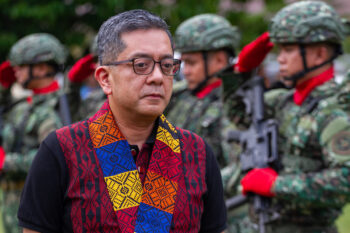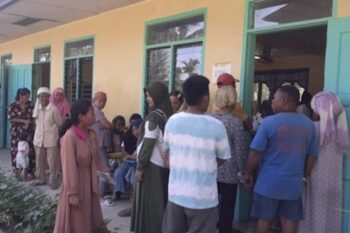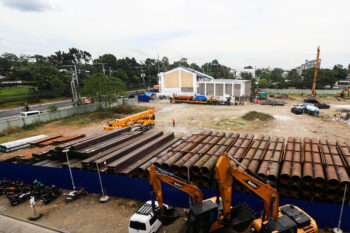GENERAL SANTOS CITY (MindaNews/18 November) – In “better” times, “embittered” Filipino nationalists and activists cry out, “Yankees, Go Home”! The Yankees stay. In “battered” times, Filipinos hope and pray, if not beg, “Yankees, S.O.S!” The Yankees come.
Last Thursday, November 14, the Yankees came to help bring aid to the devastated people, cities and towns of Leyte and Samar. They anchored their aircraft carrier USS George Washington and support ships in Leyte where General Douglas MacArthur landed 69 years ago in October 1944. This was aside from what had come and still will come from the U.S. naval base in Okinawa, Japan. Whether they will extend later the same aid to similarly ravaged areas in the Visayas media did not report so. (Philippine Daily Inquirer, November 16, 2013)
The Department of Foreign Affairs’ tally last November 13 of international aid was P3.85 billion (US$89.5 million) from 36 donors (31 countries, five organizations). Last November 14, this went up to P5.4 billion (US$ 126.8 million) from 45 donors. As of 3 p.m. of November 17 the total aid was estimated at P10.6 billion (US$248.88 million) from 43 governments and three international government organizations. This latest tally, DFA has clarified, did not include donations from non-government organizations.
By this trend, more international donations will likely come. All these, the government resources at the disposal of the President and the relief raised by civic-spirited groups in the country will lighten the suffering and hasten the recovery of all the victims and their areas. However, the Yankees’ coming has a different impact.
What have the “Yankees” brought? In PDI reports, The USS George Washington Strike Group had, besides “food and supplies desperately needed” by the typhoon survivors, 21 helicopters; the US Marine Expeditionary Brigade (MEB) from Okinawa flew in eight planes that can land in areas without runways and 10 KC-130 (Hercules) with heavy engineering equipment and about 1,200 emergency workers. A later report mentioned seven more KC-130 added and more will be coming from Okinawa. The report early this morning (November 18): “The US government has deployed more than 50 ships and aircraft to aid in search and rescue and to airlift supplies.”
In our “Mind da News” comment last November 15, conditions in Tacloban City as reported by the international media on-the-scene were bleak and desperate. The cry from the victims was “no food, no water, no help, etc.!” The NDRRMC report this morning revealed that the massive international aid, nationwide relief and government assistance have been fully mobilized; the “Yankees” have provided the means for fast delivery of immediate relief. Their cries answered, the victims and their communities will rise to celebrate a meaningful Christmas.
What have the Yankees done since their coming? The planes that brought in the emergency workers into Tacloban City flew “nearly 2,800 Filipinos and 109 American nationals out of the disaster areas”. The helicopters had flown “nearly 200 sorties” along the coasts of Leyte and Samar “dropping water and food to isolated communities”. (PDI reports of November 16)
Rehabilitation and reconstruction will speed up when “heavy equipment … generators, ‘water bull’ portable water tanks and amphibious … tracked vehicles that can operate in water and on land” arrive “in about six days”. The US Marines are assisting in clearing roads and distributing relief supplies by utility boats, land and amphibious vehicles and helicopters.
Hubs of relief operations: With airports of Guiuan Island and Borongan in Eastern Samar and Ormoc City in Leyte as the hubs of relief operations, the government relief teams are using the US Navy helicopters to “speed up aid missions” — finally reaching “the coastal municipalities of Leyte and in the southern part of Eastern Samar”. This DILG Secretary Manuel Roxas III, based in Tacloban City supervising the relief operations in the Visayas, said. (Philippine Daily Inquirer, November 16, 2013: Relief gridlock in Matnog)
Roxas, flown by a US Navy helicopter, visited Guiuan last Friday afternoon and met Rear Adm. Mark Montgomery, commander of the US Navy’s Task Force 70 (The USS George Washington Strike Group).
Optimistic but admits: Roxas told reporters: “We expect things to improve [every day]. Our work will continue. You yourselves can see that all available assets, resources and manpower of the government are being used. None of us is resting. None of us is relaxing. I believe that we can rise from this. We can rebuild Tacloban.”
He eHHHHadmitted that with only 11 trucks available government had been having difficulties in delivering food, water and other donated goods to typhoon survivors to all towns in Leyte, some of which were located hundreds of kilometers away from Tacloban, the main hub of the NDRRMC operations. As of Friday, aid from Tacloban had reached 23 out of 41 towns. This emphasizes the impact of the timely arrival of US assistance and of “the other countries [that] were also sending planes and helicopters to beef up the air support for the relief operation”.
History amuses with its contradictions. The coming of USS George Washington-led US Navy Task Force 70 will be added memory – especially to the Leyteños – to the landing of General MacArthur 69 years ago. But, will anyone bet? When the opportune moment comes, Filipino activists and rabid nationalists will cry, “Yankees, Go home!”
*** *** ***
Much ado about death toll: Why is NDRRMC making a mountain out of the hill of difference between the number of dead it has tallied and that of the United Nations? To stamp its authority, it gave notice – presumably to media and all – that its tally is the official and true number.
The figures are bound to change every day. Can all the dead be retrieved so that the number by the last day the search and recovery is stopped could be authentically – even if authoritatively – considered the true figure? Can all those lost in the sea and left under the piles of debris be recovered and counted?
The casualties are classified as dead, missing, injured. Counted dead are those recovered. The injured that later died, logically, should be included in the list of the dead. Logically, too, the unaccounted missing must be counted as dead. So, why make a big issue of the discrepancies in the counts of the dead?
The best time to validate the number of the dead inflicted by Yolanda is by the time the affected towns and villages have returned to normal. Make a census of the populations counting those who were there on November 8, 2013. Add to the census the number of residents who had left and not returned. The difference of the new census figure and the figure as of November 8, 2013 is the true “number of dead” – the unaccounted “missing” included.
For the record (The Philippine Star, November 18, 2013: Yolanda death toll leaps to 3,974): As of noon yesterday, according to NDRRMC: “The death toll has climbed to 3,974; … [with] at least 12,544 persons injured [and] 1,186 others missing.” In the November 16 PDI report: 3,621 dead; 12,165 injured; and 1,140 missing. Can 353-increase in the number of dead be considered “a leap”? But unless the missing all return alive, the increase will be “a vault”, not just “a leap”.
*** *** ***
Foreign media furor: No calamity ever got so much more international media coverage other than the devastation wrought by typhoon Yolanda. In fact, as the Manila television news reported the quite fast exit of Yolanda, I did not realize she had left so much misery in her wake until the CNA (Channel News Asia), the CNN, BBC, and Al-Jazeera gave her handiwork prime coverage and the New York Times gave it front page space – not only once but successively.
That was how the world came to consider Yolanda – internationally known as “Haiyan” – as the strongest storm on record and her destruction in the Philippines the worst. In reality, it was the international media coverage that instantly mobilized international aids and relief work teams. Yet, there were some resentment over perceived “preferential treatment” of international media and criticism for “unbalanced” reporting.
One instance: A passenger of the C-130 resented what she called preference for foreigners as the CNN was allowed to load its 100-kilo equipment when the limit for all was five kilos. Common sense: Without their equipment, the CNN crew did not have to take the C-130. What would they do in Tacloban City if they had no equipment to transmit worldwide their news?
CNN’s Anderson Cooper and ABS-CBN’s Korina Sanchez had an on-line spat. In her program she stated that Cooper did not seem to know what he was saying about the Tacloban situation. She received flaks from the social media. Again, common sense: Cooper was reporting from the scene against television footages. Korina accepted Anderson’s challenge to go to Tacloban City but only up to Ormoc City (southern part of Leyte). She did not tell reporters what she had seen.
Inquirer’s Solita Monsod had a score with media in general. She criticized media for reports about the slow response of the Philippine government without citing the difficulties that have slowed down the government. I disagree media have reported breakdowns of communication and transportation facilities.
In her column “Blame Game” (PDI, November 16), she focused “on the alleged lack of Philippine military presence”. From the AFP Chief of Staff Gen. Emmanuel Bautista and Col. Ramon Zagala she got “details of the military participation” which media had not reported. To avoid misquotations, that portion of Monsod’s column – the military report — is quoted in full below:
“Yolanda” hit land on Nov. 8 and wiped out all communications. The Army commander for Eastern Visayas, Brig. Gen. Jet Belarmino, with HQ beside the Tacloban airport, had to bore a hole in the ceiling of his quarters to survive the rising waters. And Lt. Col. Fermin Carangan of the Air Force was swept out to sea for six hours; he managed to survive, and save a 7-year-old boy in the process.
“The first military sortie was carried out on Nov. 9, by the GHQ Crisis Action Team and Medical Teams with 7,000 pounds of relief goods and food packs that were prepared four-five days earlier. The Air Force and Navy began transporting Humanitarian Assistance and Disaster Relief (HADR) assets and equipment coordinated by a command post in Tacloban (at the police station). A C-130 was used to bring 50 drums of oil for use of their other air assets in rescue and transport work. The same efforts were made in the cities of Roxas and Iloilo. Two Navy ships (DF 341 and DF 352) were also deployed to bring aid and relief goods to Carles and Estancia in northern Iloilo.
“By Nov. 9, other ships and air assets were carrying everything from cadaver bags to medicines to food, as well as communications equipment, fuel and personnel to Roxas; Kalibo, Aklan; San Jose, Antique; Guiuan, Eastern Samar; northern Panay; northern Palawan (including Coron); Negros Island; Masbate; and Cebu City. How do you think we got the information that 7,251 barangays in 471 municipalities and 51 cities in 41 provinces, involving 2.1 million families, were devastated?
“By Thursday, 15 naval vessels had transported relief goods, equipment and personnel in affected areas in Eastern and Western Visayas. Aircraft had flown 216 sorties carrying 379,369 lbs of relief goods and 267,183 lbs of other cargo (fuel, equipment, etc.). The military literally threw everything it had into the effort, including land vehicles (81 trucks), 23 aircraft, and 17 Navy vessels (from five tons to 2,000 tons). This, aside from the 3,000 men sent to help the 12,000 men already in the area. It established six monitoring hubs over the Visayas, presided over by five brigadier generals and one colonel. Serving the Filipino people.”
PDI on November 11 included in its report, “Worst Disaster to hit PH”, a statement from Zagala that “100 soldiers were sent to Tacloban to beef up the military personnel who were already there and in surrounding areas”.
Here’s a report (Philippine Daily Inquirer Friday, November 15, 2013: Food issue prevented early deployment of troops to Tacloban) citing NDRRMC Executive Director Eduardo del Rosario as saying that the “government did not immediately send a large number of troops to Tacloban City despite the desperate scramble for food because the troops themselves might also starve. The national government began to send policemen and soldiers in batches on Sunday (November 10) after looting broke out. As of Thursday (November 14) 1,200 soldiers and 800 policemen had been deployed to Tacloban City”.
Check the “military” report against later reports on-the-scene and from statements of top government officials on-the-scene like DILG Secretary Roxas, DND Secretary Gazmin, and accounts of the victims. The military reports will raise hard questions.
We understand. As much as possible, the Aquino government would like to minimize reports of deaths and damages because these would reflect negatively on its capability to cope with calamities and emergencies. The government and the military do not want their images tarnished.
But had the international media been barred, the world could not have known the truth; the Philippine government could not have received the sorely needed international assistance. [Author’s Note: Mind da News, an alternate of COMMENT, is specifically an opinion on current news. patpdiazgsc@yahoo.com]







